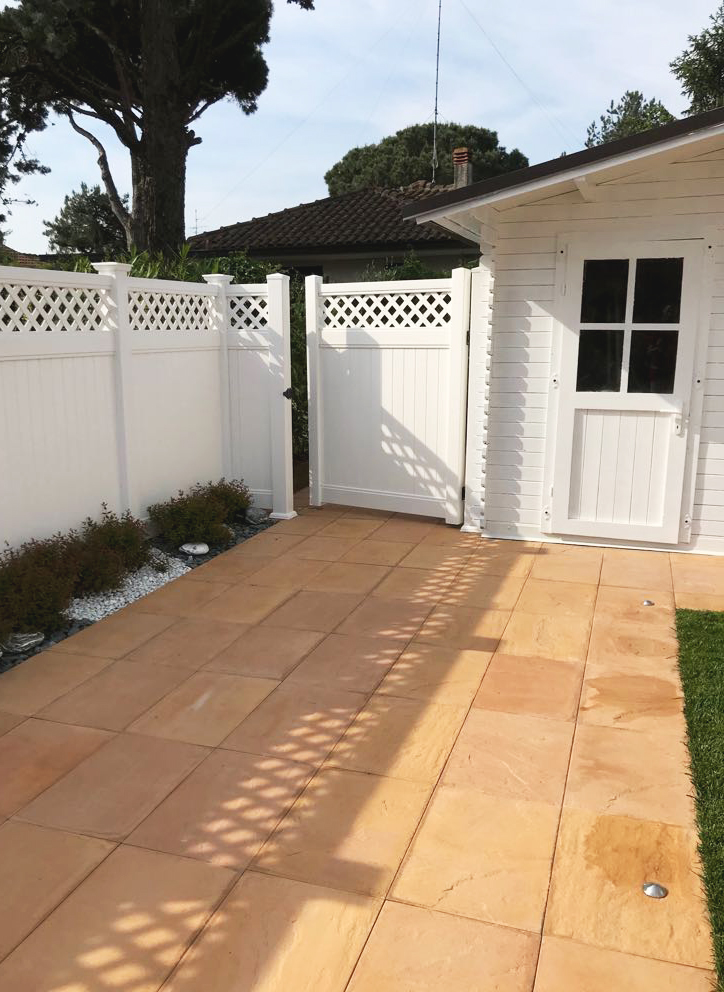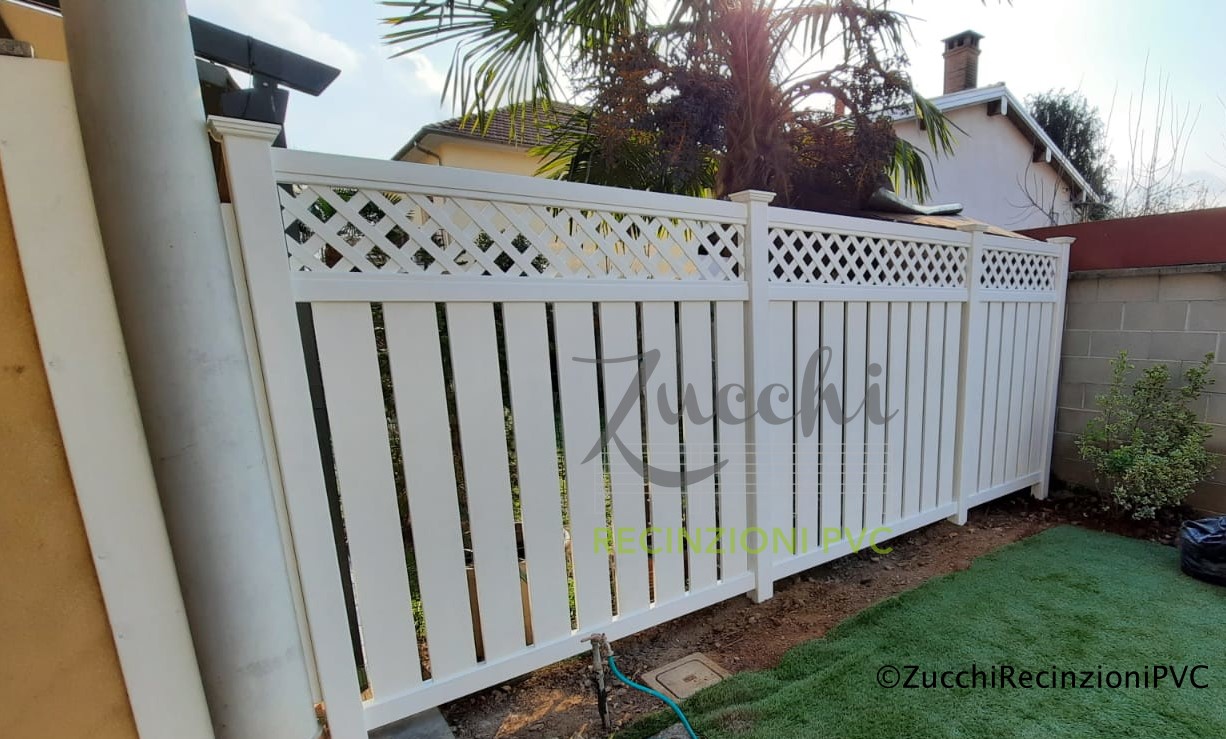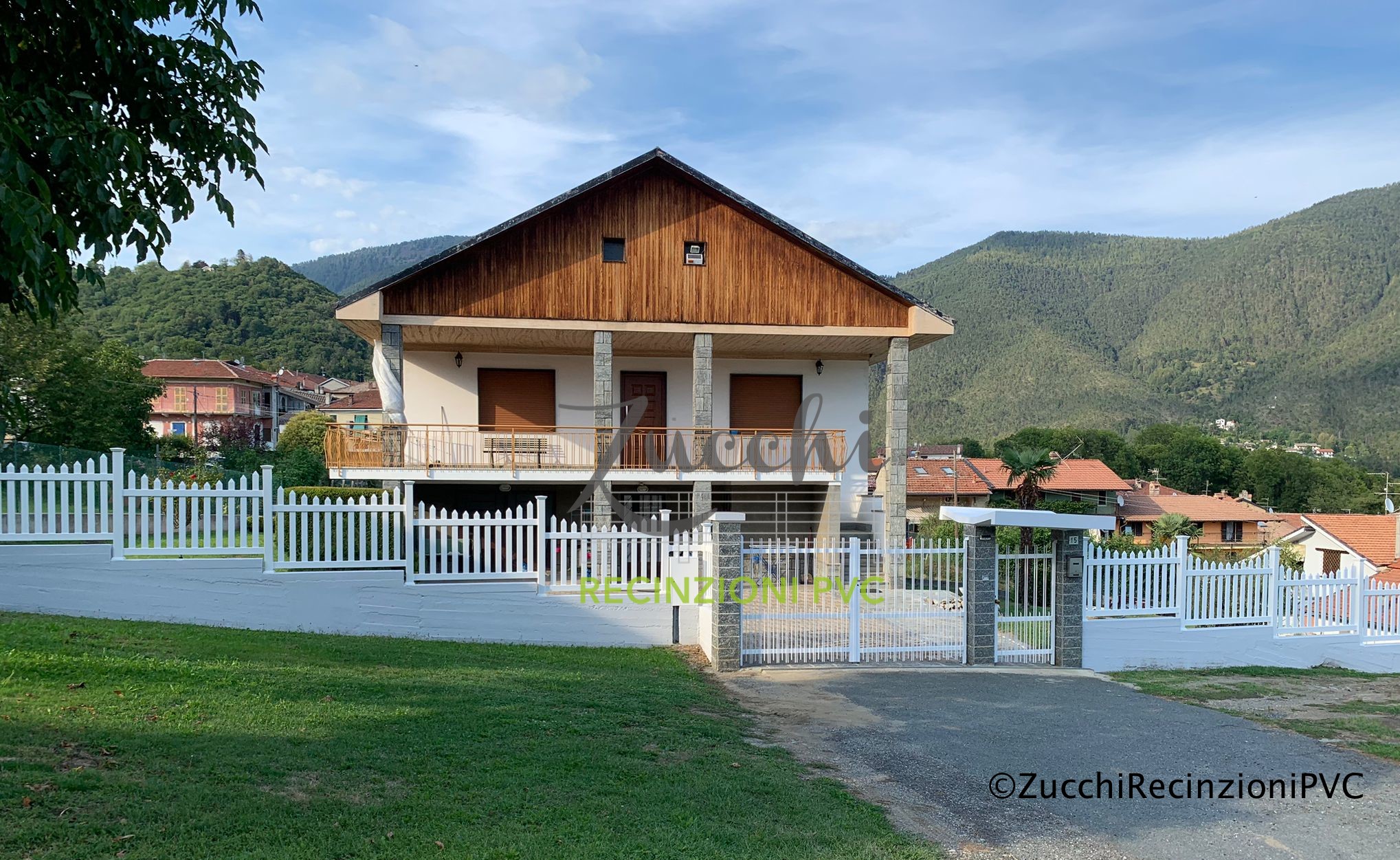Mistakes in preparing the ground: How to avoid trouble when laying PVC fencing
Laying a PVC fence sounds simple, doesn’t it? But before you start with the installation, there is one crucial step you cannot underestimate: preparing the ground. Many people think it’s enough to simply plant the posts and insert the panels, but improper ground preparation can jeopardize the whole job. If you don’t take the time to do things the right way, you could end up with a fence that is unstable or, worse, that is ruined after a short time. Here are some of the most common mistakes to avoid when preparing the ground for your PVC fence.
-
Don’t Level the Ground Properly
One of the most common mistakes when preparing the ground is not leveling it properly. If the ground is uneven, the fence will never stand straight, and you risk seeing the panels tilt in no time. Before you start digging or planting posts, take a level or even a tightrope to make sure the surface is as even as possible. Even small undulations can affect the alignment of your PVC panels, creating a fence that is not only not aesthetically pleasing, but also may not be stable in the long run.
If you feel that the ground is too sloping or uneven, you may need to add material to level it. Alternatively, if the soil is too soft, you may want to use concrete or stone slabs to stabilize the base. In short, taking the time to do proper preparation is not only a matter of aesthetics, but also of stability.
-
Ignoring the Need to Compact the Land
Another mistake many people make during preparation is not compacting the soil properly. PVC is a strong material, but the stability of your fence also depends on how solidly it is anchored to the ground. If the soil is not well compacted, the posts you insert into the ground could shift easily, especially in high winds or heavy rains. This could cause subsidence or even collapse of the fence over time.
To avoid this problem, use a sledgehammer or compaction tool to make sure the soil around the posts is well compacted. You can also consider using sand or gravel to improve stability. These materials allow for better drainage, preventing moisture from damaging the posts and minimizing the risk of sagging.
-
Do Not Consider Adequate Drainage
If you live in an area with frequent rainfall, another mistake not to make is to ignore the importance of drainage. PVC resists weathering very well, but the soil around your fence must be able to drain water properly. If you don’t consider drainage, moisture could accumulate around the posts, compromising their stability over time.
Wet and muddy ground is not an ideal environment for a fence. Water that accumulates around the posts can seep in and, over time, weaken the base of the fence. To avoid this situation, consider adding a draining base under your posts, such as gravel or stones. Also, make sure that water can easily drain away from the fence and not pool in the surrounding area.
How to Avoid These Mistakes
Now that you know the most common mistakes in soil preparation, let’s see how to easily avoid them. Start with careful planning: take the necessary measurements and make sure the ground is level before you begin. If the ground has unevenness, take immediate action to fix the problem. Next, compact the soil well around the posts and consider drainage, especially if you live in an area with heavy rainfall.
If you don’t feel confident in preparing the ground yourself, it is never a bad idea to ask an expert for help. It is often more convenient and safer to involve someone with experience than to risk making mistakes that will cost you time and money.
The Right Preparation Makes the Difference
Remember, ground preparation is the foundation of your PVC fence. If you don’t pay attention to these details, you may end up with a fence that doesn’t last or look the way you wanted. I hope these tips were helpful and made you realize how important it is to do things right from the start. Have a good job with your fence, and if you happen to make a few small mistakes, don’t worry-it’s all part of the process!
The importance of stable foundations: The solid foundation for your PVC fence
When it comes to PVC fencing, one of the most overlooked but most fundamental aspects concerns the foundation. The solid stability of your fence depends on a well-built base that can bear weight and stand the test of time. There is nothing worse than seeing a fence collapse or bend after a short time, and the cause often lies in the poorly prepared foundation. Don’t worry, in this post I will explain why foundations are so crucial and how to ensure that your fence is stable and durable.
-
Why foundations are the key to stability
The foundation is the base on which the entire fence rests. If you think of your fence as a building, the foundation is like the foundation of a house: without it, the entire structure would be at risk. PVC fences, although strong, need proper support to remain upright and functional over time. If the base is not strong enough, the posts can move or give way, and the fence could warp or even fall down. So although PVC is a durable material, a bad foundation makes it all worthless.
When preparing the ground for your fence, you should focus on making a stable and level base. This means that the posts should be well anchored in the ground and supported by materials that can evenly distribute the weight. Without a solid foundation, high winds, rain and vibration could damage your fence. For this reason, although it may seem like a tedious step, preparing the foundation well is a step that will save you a lot in the long run.
-
The different types of foundations for PVC fencing
There are different types of foundations you can use for your PVC fence. The type you choose will depend on the nature of the soil, the weather conditions, and the type of fence you want to install. Here are some of the most common methods:
- Concrete foundation: One of the most robust solutions is to fix the posts in concrete foundations. This type of foundation offers exceptional stability and holds up well to even the softest or sandiest soils. Simply dig holes, pour the concrete, and insert the posts before it dries. This method is especially useful in areas where the wind is strong or the ground tends to shift.
- Gravel or sand foundation: If the soil is well drained and stable enough, you can opt for a gravel or sand foundation. This type of foundation is less expensive and faster to prepare, but still offers good stability. Gravel also helps with drainage, preventing moisture from damaging the posts over time.
- Prefabricated stakes or pickets: In some cases, if the ground is solid enough, you can consider using prefabricated stakes or steel pickets, which are driven directly into the ground. This method is faster and less expensive, but it requires careful soil testing to prevent the stakes from shifting.
Remember, the choice of foundation depends on local conditions and the type of fence you want to install. Don’t go the extra mile: choose a system that will provide the necessary support for your fence.
-
How to ensure a lasting foundation
For your PVC fence to last, it is important to make sure that the foundation is designed to withstand it. Here are some tips to ensure a stable and durable foundation:
- Soil preparation: First, make sure the soil is well compacted and free of debris or roots. If the soil is too soft, add stabilizing material such as sand or gravel. Well-prepared soil is essential to prevent the poles from shifting over time.
- Lay cement carefully: If you decide to use cement, don’t forget to leave enough space between the pole and the cement to allow the material to expand naturally. In other words, don’t pour the cement directly around the pole: leave at least a few inches of space to prevent the PVC from being damaged by moisture or temperature changes.
- Draining bottom: If the soil tends to stay wet, add a layer of gravel or sand to the bottom of the hole before inserting the post. This will ensure that water does not pool around the base, reducing the risk of damaging the PVC over time.
- Periodic check: After completing the installation, regularly monitor the stability of your fence. If you notice any posts moving or tilting, don’t put off repairs. It is always better to fix small problems before they become major ones.
Stable foundations for a long-lasting fence
Ultimately, if you want a PVC fence that will withstand the years and the elements, you cannot afford to ignore the importance of the foundation. Your foundation is what ensures the longevity and stability of your work. Take the time to properly prepare the soil and choose the right type of foundation for your situation. With a solid foundation, your PVC fence will be able to protect your garden for many years without worry.
How to avoid damage when installing PVC fence
Mounting a PVC fence may seem like a relatively simple task, but as with any do-it-yourself project, there are pitfalls. Once you’ve chosen your material and prepared the ground, it’s time to assemble the panels and posts. However, if you’re not careful, it’s easy to damage the PVC or compromise the integrity of the fence. But don’t panic! With a few tricks and good preparation, you can avoid damage during assembly and get a perfect result. In this post, I will guide you step by step on how to make sure that the assembly of your PVC fence goes smoothly and without a hitch.
-
Use the right tools
One of the first mistakes many people make when putting up a fence is not using the right tools. You might think that a few basic tools are enough, but every detail counts. If you use unsuitable tools, you risk ruining posts or damaging PVC panels. To avoid damage, make sure you have at least the following tools on hand:
- Electric drill: For drilling holes in the ground or fixing poles to the base.
- Bubble level: To ensure that everything is perfectly aligned and level.
- Rubber sledgehammer: Useful for not damaging the poles when driving into the ground.
- Rope and stakes: To draw a straight and stable guide line.
By using proper tools, you will greatly reduce the risk of making mistakes that could ruin the appearance and stability of the fence. Don’t settle for what you have on hand: invest in the right equipment for a job done properly.
-
Avoid forcing PVC
PVC is a strong material, but like any plastic, it has its limitations. A common mistake during installation is to force panels or posts into holes or supports. PVC can crack or break if subjected to excessive stress. So even if it looks like the panel will not fit easily, stop for a moment and check.
Make sure the holes are wide enough to accommodate the post without forcing it through. If necessary, use a file or saw to widen the hole slightly. Also, when inserting the panels into the posts, do it slowly. The use of a rubber mallet can be very helpful for leverage without damaging the PVC.
Another trick is not to pull the panels or screws too tight. If the screws are too tight, they could cause cracks in the material. When you mount the panels, apply moderate force to ensure a good fit without damaging the PVC.
-
Be careful not to scratch the PVC
Although PVC is durable, it is quite easy to scratch it, especially during installation. Scratches not only spoil the appearance of the fence, but can also weaken the material, making it more vulnerable to external damage. How can you avoid these annoying scratches? Here are some practical suggestions:
- Work in a clean area free of sharp objects: Make sure the ground is clean and there are no stones or debris that could scratch the surface.
- Handle panels with care: When lifting or moving panels, do so carefully. Use work gloves to protect the PVC surface during transport.
- Place the panels on a soft surface: If you need to lay the panels on the ground during installation, use a soft cover, such as a blanket, to avoid accidental scratches.
Also, if you happen to notice a scratch, don’t despair. There are specific PVC recovery products that can be used to reduce the visibility of scratches and keep your fence looking like new.
-
Do not ignore the correct alignment
One of the key aspects during the installation of a PVC fence is alignment. Not only for a flawless aesthetic result, but also for the stability of the fence. If you don’t take the time to align the posts properly, your fence may be tilted or even unsafe. The best thing to do is to use a rope and stakes to mark a straight line where the posts are to be placed. This way, you will always have a clear reference point and can make sure everything is lined up perfectly.
To be even more precise, use a spirit level for each pole. Although it may seem like a small detail, having each pole perfectly straight will ensure that the entire structure is stable and long-lasting. Aligning the poles correctly is a step that will save you many subsequent problems.
-
Check the weather conditions
Never forget that weather conditions can affect the installation of your fence. If you are installing your PVC fence on a very hot or cold day, be careful. PVC tends to become more brittle in cold weather and may break if subjected to stress. Conversely, in hot weather the material can become too pliable, risking easy deformation.
Choose the best time for installation, preferably during a temperate day. If you are working with PVC on a hot day, be careful not to overload the material. If, on the other hand, you are on a cold day, try not to force the panels or posts too hard.
Why the choice of screws and fasteners is crucial for your PVC fence
When it comes to installing a PVC fence, many people focus primarily on the design and quality of the material. Yet, there is an equally crucial aspect that is often overlooked: the choice of screws and fasteners. Yes, it sounds like a detail, but the truth is that the right screws and fasteners make a huge difference. If you don’t pay attention, you risk compromising the stability and durability of your fence. That’s why it’s critical to choose the right fasteners for the job. I’ll explain why!
-
Fence stability depends on the right screws
You might think that any screw will do for mounting a PVC fence, but that’s not the case at all. Screws are the “joints” that hold the entire structure together, and if they are not strong enough or appropriate for the material, you risk seeing your fence fail after a short time. PVC, while a strong material, needs screws that can anchor securely without damaging it.
The right screws must be able to withstand daily pressure and vibration. This is especially important in windy environments or in places where the fence is exposed to frequent temperature changes. In these cases, low-quality screws could loosen, causing unwanted movement or even damage. If you don’t want your fence to “dance” every time a little wind blows, be sure to choose strong, suitable screws.
-
Stainless steel screws: the best option to resist weathering
When choosing screws for your PVC fence, not all screws are the same. One of the best choices is to opt for stainless steel screws. Why? Because these screws are particularly resistant to rust and corrosion. If you don’t want your fence to start losing its beauty and strength after a few seasons of rain, stainless steel is the way to go. Galvanized steel screws are a good option, but stainless steel is tops when it comes to durability.
Imagine if after a few months, due to rain and moisture, the screws of your fence begin to deteriorate. Rust could affect the posts and panels, and the structure becomes brittle. By choosing stainless steel screws, you can avoid these kinds of problems and ensure that your fence will remain intact for years without worrying about corrosion.
-
Self-tapping screws vs. regular screws: why they are essential
The choice between self-tapping screws and regular screws may seem like another small decision, but it is not at all. Self-tapping screws are especially useful for PVC because they do not need a pre-drill hole. They allow you to attach the panels directly without having to pre-drill the material, which makes the assembly process much faster. But it’s not just a matter of speed: these screws, when used correctly, provide a firm, strong grip without damaging the PVC.
Translated with DeepL.com (free version)
Normal screws, on the other hand, may need a larger hole, which could lead to damage during insertion. Also, if they are not long or strong enough, they risk not holding the panels well, causing the fence to become unstable. Therefore, to achieve a secure fastening, never underestimate the importance of choosing the right screws for the material.
-
The importance of screw length and position
Another aspect that many people ignore is the length of the screws and their location. It sounds trivial, but choosing the right length for the screws is crucial to ensure the tightness of the fence. If the screws are too short, they will not properly anchor the panel to the post, leaving room for unwanted movement. If they are too long, they risk going through the PVC, damaging the surface and weakening the material.
The position of the screws is also essential. They should be evenly distributed on the panels and posts to prevent the fence from becoming unbalanced. Ideally, you should place the screws so that they are evenly spaced from each other, without overloading a single point. This helps to better distribute the weight and stresses, increasing the stability of the structure.
-
Considerations on the type of support and attachment
Don’t forget to choose the most appropriate type of fastener for your PVC fence. Depending on the model of fence you are installing, you may need to use specific supports or attachment clips. Some PVC fence systems, for example, require the use of plastic clips or hooks to hold the panels in place, without the need for traditional screws. Others, however, require flat-head screws to ensure that the panels attach securely without damaging the material.
Each type of fence has its own requirements, so be careful to consult the manufacturer’s instructions and choose the right fasteners. Using the right components for the type of fence you have chosen will ensure that the structure remains secure and stable over the long term.
Conclusion: Small choices, big difference
Ultimately, the choice of screws and fasteners for your PVC fence is a detail you cannot afford to ignore. These small components have a huge impact on the durability and stability of your fence. Choose stainless steel screws, prefer self-tapping ones for quick assembly, and pay attention to the length and distribution of the screws. With these simple precautions, your fence will be strong, secure and will last over time without any problems. Remember: even the smallest details can make a big difference!







Leave A Comment